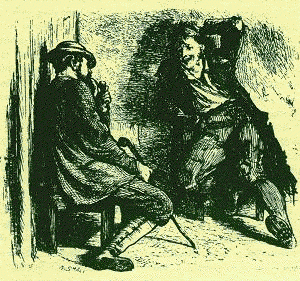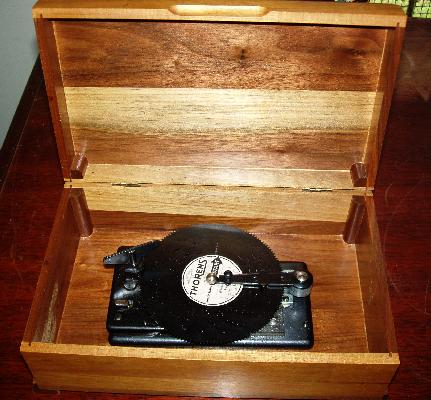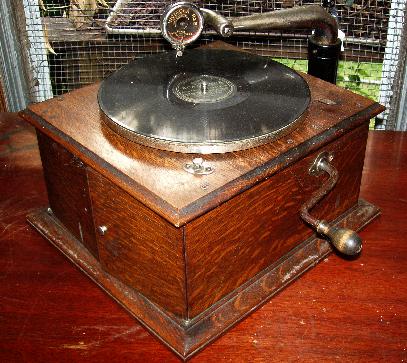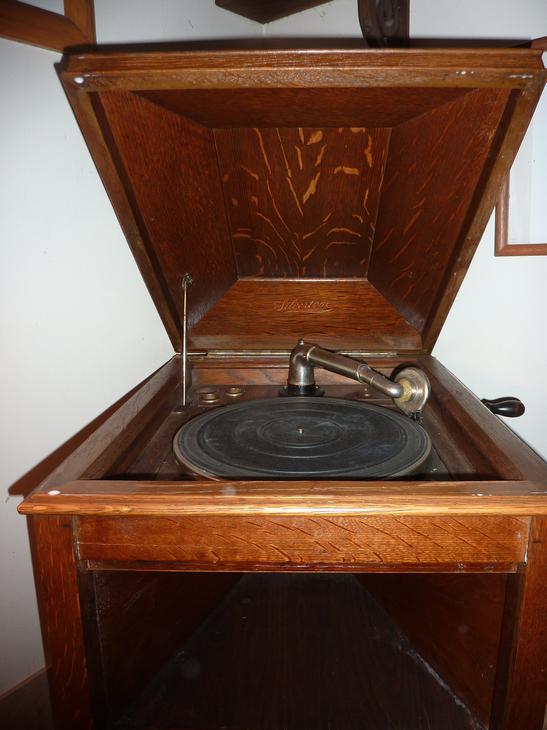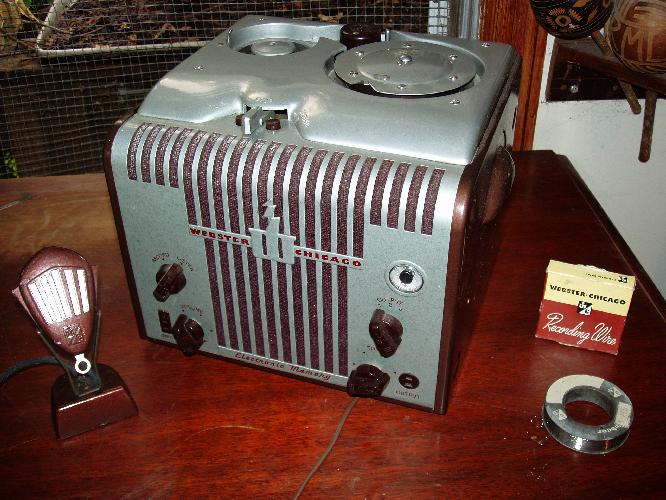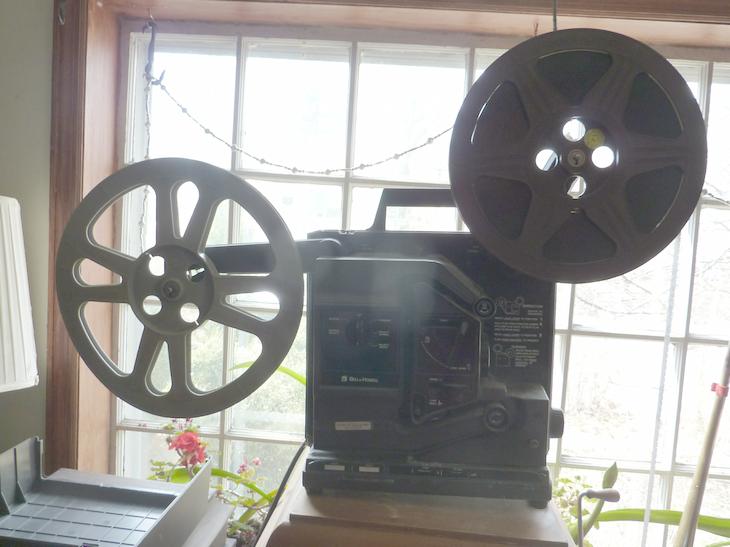| Conservation
and Preservation- As with all historical
objects and antiques recording and playing mechanisms and media require
special care. Recordings should be transferred to modern media so that
they last longer. Original recordings should be played carefully and
infrequently so that they will not wear out.
Always handle media and mechanisms carefully using
cotton gloves to keep body acids from corroding them. Temperature and
humidity controls should be maintained with as little fluctuation as
possible. Metal surfaces should have a protective barrier a light coating
of microcrystalline wax except in the case of moving parts which should be
coated with light oil. Wax cylinders require special care to avoid and
remove mold. If mechanisms are to sit out they should be covered to
protect them from dust. If mechanisms and media are in a sun lit room
windows should be coated with a uv barrier or film to prevent damage to
wood.
Students should be encouraged to investigate the
physics, chemistry and ecological dimensions of conservation and
preservation. Preparation for safe and conservationist encounters with
historical materials is essential and will result in the creation of a
more positive environment for these materials.
Here is what the Library of Congress recommends-
|
HANDLING |
| General |
Do not touch the playing surface/s of any recording.
Clean hands before handling recordings. |
| Discs |
Handle all grooved discs (78s, 45s, LPs, and acetate
discs) by their edge and label areas only. Handle compact discs by
outer edge and center hole only. |
| Tape (Open Reels) |
Handle by the outer edge of the reel flanges and
center hub areas only. Do not squeeze flanges together -- it will
damage tape edges. |
Tape (Cassettes,
Audio and Video) |
Handle by outer shell, only. Do not place fingers or
any other materials into openings. |
| Cylinders |
Handle by inserting middle and index fingers in the
center hole, then gently spread them to just keep the cylinder from
slipping off. Do not touch the grooves of wax cylinders; they are very
susceptible to mold. Wax cylinders should be at room temperature
before touching; the thermal shock from the warmth of your hand can
cause cold wax cylinders to split. |
|
STORAGE |
| General |
Keep all discs and tape both open-reel and cassettes standing
upright, on edge. Store cylinders standing on their ends. Do not lay
any recording flat, not even audio or videocassettes. |
| Environment |
Keep all storage and use areas clean. |
Medium-term
Storage |
(materials to be preserved for a minimum of 10 years, ANSI IT9.13,
1996) Storage areas should be kept at a constant 65 to 70° F and 45 to
50% Relative Humidity (RH). Widely fluctuating temperature or RH
severely shortens the life span of all recordings. Environmental
conditions shall not fluctuate more that ±10 F or ±10% RH over a
24-hour period. Keep recordings away from light, especially sunlight
and unshielded fluorescent lights. |
| Long-term Storage |
(Materials having permanent value) Storage areas should be kept at
a constant 45 to 50° F or colder (do not store magnetic tapes below
46° F as it may cause lubrication separation from the tape binder) and
20 to 30% RH for magnetic tapes (open reel and cassette) and 45 to 50%
RH for all others. Widely fluctuating temperature or RH severely
shortens the life span of all recordings. Environmental conditions
shall not fluctuate more that ±5° F or ±5% RH over a 24 hour period.
Store in dark areas except when being accessed, being sure to keep
recordings away from UV sources (unshielded fluorescent tubes and
sunlight.) |
| Tape Demagnetization |
In general, demagnetization is not a problem in most situations.
For an added margin of safety to prevent demagnetization keep all tape
(open reels and cassettes) away from potential sources of
demagnetization, such as loudspeakers, most of which have sizable
magnets in them. Do not set tapes on top of or leaning against any
equipment which can be a source of either magnetic fields or heat. Be
careful about operating machines with electric motors (e.g., vacuum
cleaners) next to tape storage areas. |
| Shelving |
Recordings are surprisingly heavy. For example, LPs average
between 35 and 45 pounds per shelf-foot; 78 rpm and acetate discs are
even heavier. Because of their shape and the design of their
packaging, recordings will concentrate their weight in the centerline
of a shelf, which can cause some shelving to collapse. Make sure that
the shelving you choose is solid and well constructed. |
| Discs |
Must be shelved vertically. Ideally, disc shelving should have
full-height and full-depth dividers, spaced 4 to 6 inches apart, and
secured at top and bottom. Less than full-height dividers may
contribute to warpage. Interfiling discs of different diameter may
also cause warpage. |
| Tapes (Open reel) |
Boxes should be stored vertically. Dividers are not essential, but
the boxes must be secured with a bookend and not allowed to fall. |
Tapes (Cassettes,
Audio and Video) |
Cassettes in water repellent plastic containers should be stored
vertically "on edge," not flat. |
| Cylinders |
Stored standing "on end," like a drinking glass. |
| Winding tapes |
Contrary to what your local video-store may say, tapes, including
cassettes, should not be stored in the rewound or fast-forwarded
position. Ideally, play a tape completely through, then store it
without rewinding. Rewind it just before playing it again. |
|
CLEANING |
| Cleaning Solution for Audio Records
CD's and DVD's |
A simple, environmentally-friendly
solution has been developed for cleaning acetate/lacquer, shellac, and
vinyl records as well as CD's and DVD's. This solution has been used
very satisfactorily at the Library of Congress. We have not compared
it for its effectiveness against commercial products and have no
intention to do so at present. While most of the lacquer records
respond readily to this cleaning solution, a few isolated examples
tend to retain a wax-like deposit that is resistant to this cleaning
solution. A supplemental solution for cleaning such records is under
development. |
| Disclaimer |
While the Preservation Directorate is
pleased to share this information, no guarantee is implied or intended
that it will meet the needs of all users. Institutions or individuals
who prepare or use the solution or solvents described here, must do so
at their own risk. The Library of Congress will not be liable for any
injury to any person or damage to any item resulting from the use of
any of the materials, chemicals, solvents or procedures described
here. |
|
Precautions |
We strongly advise against
the preparation of the cleaning solution or its use, as well as the
use of solvents by persons who are not trained in the safe handling of
chemicals. Even well-trained persons should not prepare this solution
at facilities that are not equipped with a working fume-hood that
provides an acceptable air flow. Safety glasses must be worn during
the preparation and use of the cleaning solution or the recommended
solvents. Material safety data sheets (MSDS) for all ingredients and
solvents must be made available to all persons involved in any of the
procedures presented here. These documents can be obtained from the
providers of the individual chemicals. |
Solution
Preparation |
Water used to prepare this solution and to wash
cleaned items must be of the highest quality. Ideally, distilled water
or at least water purified by a reverse osmosis system and/or by
filtration through deionizing cartridges should be used. The
ingredients used in the formula for the cleaning solution are clearly
identified below. MSDS's need to be consulted, and implications for
the health of the users need to be clearly analyzed and understood
before the preparation and use of this solution.
Preparation of the cleaning solution
To prepare 1 gallon (4 liters) of solution, half-fill a gallon
bottle with water and add:
- Triton™ XL-80N surfactant, 20 ml (0.5 percent). This is the
active cleaning agent in the formula. It is available from Union
Carbide Corporation, which is now a part of Dow Chemicals. Its main
advantage is that it is designed to rinse out more easily than most
other surfactants.
- Ammonia liquor (analytical reagent grade), 20 ml (0.5 percent).
We analyzed the white deposits commonly found on acetate discs and
determined that they consist of fatty acids which are formed as a
result of degradation of the plasticizers that were introduced in
their manufacture. This ingredient needs to be included only for the
cleaning of acetate records. It will not hurt other records, but it
may not necessarily clean them better.
- Alkyl dimethyl benzyl ammonium chloride, 0.5 ml (0.13 percent).
One source of this chemical is Chemetall Oakite of Berkeley Heights,
NJ, who sells it as "Oakite Sanitizer 1." This ingredient is added
to inhibit the growth of micro-organisms during storage. It is also
useful for disinfecting records which might have mold on them, but
it does not influence the cleaning action.
- Enough water to make the solution up to a full gallon.
- Cap the bottle tightly and invert it a few times to mix the
solution thoroughly.
Note: It may be safer and more convenient to prepare a stock
solution containing 10 times the concentrations of all ingredients,
from which the solution for actual use can be readily prepared by a 10
time dilution. |
| Directions for Use |
This cleaning solution can be used to clean records
manually or in mechanized record cleaners. In either case, the
cleaning step needs to be followed by a rinsing step in which residual
cleaner is removed by washing with water. The disc is finally wiped
dry using a soft, nonabrasive, lint-free cloth. This last drying step
may not be necessary if a record-cleaning machine with a vacuum arm is
being used. |
| Disposal of waste and chemicals |
This solution is dilute enough, and the chemicals used
innocuous enough so that the waste solution after cleaning of records
can probably be disposed of down the drain. However, we would
strongly recommend confirming this disposal practice with the local
water authority, especially if significant amounts of the cleaning
solution are routinely discharged into the waste stream. Direct
disposal of any of the undiluted stock chemicals used in the
preparation of this solution must always be undertaken only through an
appropriately certified company or organization. |
|
PACKAGING, CONTAINERS
|
| Discs |
Most record sleeves should be replaced with a high
density polyethylene such as DiscWasher V.R.P., Mobile Fidelity
Original Master Sleeve, or Nagaoka No. 102 Anti-Static Record Sleeve.
If an original paper sleeve contains text or graphics, the Nagaoka
sleeves are thin enough to fit inside the paper sleeve.
Some plastic or plastic-lined sleeves should not be used. As a rule
of thumb, "bad" sleeves are clear and have a sticky or tacky feel
whereas "good" sleeves are frosted in appearance and have a slippery
feel. |
| Tape (Open reels) |
Replace any reel which has a slotted hub. Only reels
with unslotted hubs are acceptable for storage. Reels with slotted
hubs may be used as take-up reels. |
|
PLAYBACK
EQUIPMENT MAINTENANCE |
| Clean equipment (tape heads, guides, etc.) often and thoroughly
with isopropyl alcohol and cotton swabs. Demagnetize tape decks
periodically; if you are unsure about doing this leave it to a
professional. Clean the phonograph stylus before playing each disc
side using a densely packed bristle brush such as DiscWasher's SC-2 or
LAST's stylus cleaning brush. Learn how to balance and set the
tracking and anti-skating on your tone arm. Check the settings at
least once a month or anytime you hear mistracking. |
|
BIBLIOGRAPHY
|
| GENERAL WORKS
- Child, Margaret S. Directory of information sources on
scientific research related
- to the preservation of sound recordings, still and moving
images, and magnetic tape. Washington, D.C.: Commission on
Preservation and Access; c1993. 14 p.
- Gibson, Gerald D. "Preservation and conservation of sound
recordings." In: Henderson,
- Kathryn Luther; Henderson, William T. Conserving and
preserving materials in non-book formats. Allerton Park
Institute Conference; 1988 November 6-9; Urbana. Urbana-Champaign,
Illinois: University of Illinois at Urbana-Champaign. Graduate
School of Library and Information Science; 1991. 27-44.
- Media Stability Studies : Resources for archivists, records
managers, and individuals responsible
- for storing information at www.nml.org/MediaStability
- Pickett, A. G.; Lemcoe, M. M. Preservation and storage of
sound recordings : A Study
- supported by a grant from the Rockefeller Foundation.
Washington, D.C: Library of Congress; 1959. vii, 74 p.
Note: Bibliography; photographs; illustrations;
diagrams. Reprint available from Association for Recorded Sound
Collections; attn Elwood McKee; 118 Monroe St., Apt. 610; Rockville,
MD 20850-2511. The basic document on the preservation and storage of
all audio recordings before CDs reports on a study of preservation
and storage of the more common sound recordings of the period.
Conclusions include information and-or recommendations on storage
environment, control of mold and fungus, furniture, and packaging.
- Schiller, Dietrich. "Handling, storage, and preservation of
sound recordings under tropical and
- sub-tropic climatic conditions." IN: Fontes Artis Musicae;
1986; (33): 100-104.
- Varcla, Allan. "Art of audio archiving in the '90s." Pro
Sound News. 1994 Mar 15;
- Note: Presents the complications in archiving
that have taken place with the advent of digital audio recording
technology, most notably incompatibility of systems and/or media.
Presents comments on analog tapes from John Matarazzo, manager of
technical services for Sony, concerning binder breakdown,
crystallizing or oxidizing of lubricants, and treatment resulting in
temporary stability in order to make working copies; continues with
uncertainty of how well digital tapes store and critical nature of
temperature and humidity in storage, with information on metal
evaporated tape, with some of advantages of optical recording
technology, that Open Media Framework (OMF) is addressing problem of
incompatibility and back up systems. "The requirements of OMF are
that we continually keep it backwardly compatible so, as we extend
the capabilities in the file format and the specification, we will
continue to support the things that were in there originally. That
means that you can never have an OMF file that you can't go back to
and open and process with the capabilities that you have at that
time."
- DISC RECORDINGS
- American National Standards Institute. Optical disc media :
Storage. New York LANSI,
- 1997 (ANSI/NAPM IT9.25-1997).
- Berger, Myron. "Record Cleaners and the Real World." High
Fidelity 3 (7): 43-46 (July 1980)
- Bouley, Raymond J. "The Life and death of CD-ROM." CD-ROM
Librarian. 1992 Jan : 146-151.
- "Compact disc problems." Conservation Administration News.
1989; (36): 20.
- Note: Information on problems with compact disc
in relation to deterioration caused by label ink, oxidation of
aluminum, and storage conditions.
- Day, Rebecca. "Where's the rot? A Special report on CD
longevity." Stereo Review. 1989 Apr; 54(4): 23-24.
- Fantel, Hans. "Pampered record can live to be 100." New York
Times. ; 1976 Oct 10; D: 26-28.
- Note: Reports on tests of LP record wear, and
on cleaning devices and agents, measuring the increase of noise and
distortion in successive plays of discs cleaned each time before
playing. Concludes that such a disc almost as good after 200 plays
as when new, but that a dirty, neglected disk may be badly damaged
in less than twenty plays.
- Fantel, Hans. "Keeping it clean : Solutions for record care."
Opera news. 1977 Apr 2; 41: 38-39.
- Note: Includes information on Zerostat,
Staticmaster, Discwasher, Radio Shack's Hydro-Stor, Audio-Technica's
AT610, Watts' Disc-Preener and Manual Parastat, Audio Technica
AT6002, Vac-O-Rec, and Fidelipac's Spin & Clean Record Washer.
- Foster, Edward J. "A Selected--and Selective--Bestiary of
Disc-Care Accessories." High Fidelity 28
- (2): 43-48 (February 1978)
- Hyperion Bronzed CDs : A Note about corroding CDs manufactured
by Philips and DuPont Optical
- at www.hyperion-record.co.uk
- Lumley, Enid. "Record Cleaning Machines." IAR Hotline
23: 7-17 (July 1982)
- Lumley, Enid. "Record Cleaning Fluids." IAR Hotline 23:
1-7 (July l982)
- Maier, Bruce. "In Search of the Perfect Record Cleaner."
High Fidelity 22 (9) 52-55 (September 1972)
- Mastricola, Scott. "Record Wear." Stereo Review 36 (6):
56-60 (July 1976)
- Pisha, B. V. "Record Cleaners Revisited." Audio 54 (5):
40-49 (May 1970)
- Ranada, David. "How to Handle Records." Stereo Review
47 (9): 62-63 (September 1982)
- Saffady, William. "Stability, care, and handling of microforms,
magnetic media, and optical
- disks." Library Technology Reports. 1991 Feb; 27(1):
5-116.
- Note: Bibliographic references. Reports on
survey of currently available information about the stability, care,
and handling of non-book media, including microforms, magnetic
media, and optical disks. Organized according to media type, each
including an introduction to the media and to its physical and
application characteristics; description of recording technologies
and technical processes; scientific information about stability;
discussion of environmental and other factors which can affect the
chemical behavior and physical properties of the media; and
guidelines for care, handling and storage.
- Woodcock, Roberick; Wielage, Marc. "Laser rot." Video.
1987 Apr : 49-52.
- Note: Includes description of deterioration of
signal on video discs and possible causes; gives partial list of
some titles where problem has been found.
- TAPE RECORDINGS
- Ampex Corp. Guide to the care and handling of magnetic tape.
Redwood City, CA:
- Ampex Recording Media Corp.
- Note: Modified reprint included in VanBogart,
John W. C.: Magnetic tape storage and handling : A Guide for
libraries and archives (Washington, D.C., St. Paul, MN;
Commission on Preservation and Access, National Media Lab, 1995)
- Ampex Corp; Ostertag, John. Product Information : 467 R-DAT
Digital Audio Tape :
- Competitive Performance Review [press release]. Redwood
City, CA: Ampex Recording Media Corp.; [1994]. 3 p.
- Note: Reviews the performance characteristics
of the cited Ampex product; in doing so, includes the strongest
statement yet from a manufacturer concerning use of R-DAT as an
archival medium: "Ampex's position about archiving valuable source
programming to R-DAT is simple. We do not recommend it." They, then,
give three reasons why it is not advocated: retrievability of
damaged analog vs. total loss of digital data; future access to
recorders and lack of experience with media and systems; and
doubtful interchangability of tape and machines.
- Audio Engineering Society. AES Recommended practice for
audio preservation and restoration:
- Storage of polyester-based magnetic tape. New York; AES.
1997 (AES22-1997)
- DeLancie, Philip. "Sticky-shed syndrome: Tips on saving your
damaged tape."
- In: Mix Magazine; 1990 May: 148-152.
- Note: Describes the problems, the likely
causes, and a proposed solution to the sticky-shed problem with
magnetic tape.
- Fox, Barry. "Master tapes come to sticky end." In: New
Scientist; 1992 September 22; 127(1735): 15.
- Note: Reports problem of deteriorating sound
recording tape, result of which is that the tapes are very difficult
to run and may, in serious cases, jam in the recorder. The cause is
thought to be the deterioration of the polyurethane binder used to
hold the magnetic material onto the tape base, probably caused by
hydrolysis of the polyurethane brought about by atmospheric moisture
adsorbed onto the tape surface. A method for temporarily reducing
the problem so that copy recordings can be made is described.
- VanBogart, John W. C. Magnetic tape storage and handling : A
Guide for libraries and archives.
- Washington, D.C., St. Paul, MN: Commission on Preservation and
Access, National Media Lab; 1995. [4], ii, 34 p; ISBN:
1-887334-40-8.
- Note: Available from Commission on Preservation
and Access; 1400 16th St., NW, Suite. 740; Washington, D.C.
20036-2217. Illustrated; bibliography; glossary. Includes reprint of
Ampex 'Guide to the care and handling of magnetic tape'; estimation
of magnetic tape life expectancies; and a resources list for
transfer and restoration of video and audio tape. Focuses on how to
properly store and care for magnetic media to maximize their life
expectancies. Includes technical explanations for the rationale
behind recommended procedures, written specifically for those who do
not have a significant background in recording technology. Topics
covered include what can go wrong with magnetic media, preventing
information loss, life expectancy (how long will magnetic media
last), prevention of premature degradation (care, handling, storage,
staging, refreshing of media), and a reprint of the Ampex 'Guide to
the care and handling of magnetic tapes.'
|
|
Supply Sources |
Bill Cole
Enterprises
P.O. Box 60 Dept. RLC2
Randolph, MA 02368-0060
Tel: (781) 986-2653
Fax: (781) 986-2656
E-mail: bcemylar@internetmci.com |
DiscWasher,
Inc.
A Div. of Recoton
46-23 Crane Street
Long Island City, NY 11101
Tel: (800) 223-6009
Fax: (718) 784-1080 |
Gaylord
Brothers
PO Box 4901
Syracuse, NY 13221-4901
Tel: (800) 634-6307
Fax: (800) 272-3412 |
LAST
The LAST Factory
2015 Research Drive
Livermore, CA 94550
Tel: (925) 449-9449
Fax: (925) 447-0662 |
Merit Champion
Attn: Artie Chaplin
40-46 28th Street
Long Island City, NY 11101
(212) 301- 0105
Fax: (212) 320-4354 |
Nitty Gritty
Record Care Products
4650 Arrow Highway, F-4
Montclair, CA 91763
(909) 625-5525
Fax: (909) 625-5526
E-mail: www.nittygrittyinc.com |
University
Products
P.O. Box 101
517 Main Street
Holyoke, MA 01041-0101
(800) 628-1912
Fax: (413) 532-9281
E-mail:
jadunphy@universityproducts.com |
V.P.I.
Industries Inc.
77 Cliffwood Ave. No. 3B
Cliffwood, NJ 07721
(732) 946-8606
Fax: (732) 946-8578 |
The preservation procedures described here have been used by the
Library of Congress in the care of its collections and are considered
suitable by the Library as described; however, the Library will not be
responsible for damage to your collection should damage result from the
use of these procedures.
Revised 7/02
Source-
http://www.loc.gov/preserv/care/record.html
Save Our Sounds: America's Recorded Sound
Heritage Project
Preserving Sound Recordings
by Stephanie A. Hall
Original instantaneous sound recordings are in need of special
preservation care. Today many of these historical sound recordings are
reaching the end of their life span.
Wax cylinders, the earliest sound recordings, were made from a mixture of
different waxes. The special wax mixture had to be soft enough to scratch
with a needle, but hard enough to hold the groove and play back. Over the
decades the different waxes in the cylinder try to separate, gradually
destroying the recording. Cylinders also break very easily. Because of
their age, cylinders often need attention before preservation copies can
be made from them. Even broken cylinders can sometimes be carefully
reassembled and played. In addition, the equipment needed to play
cylinders for duplication is becoming rare. Playing the cylinder must be
done with great care in order not to damage the delicate grooves in the
wax.
Aluminum disc recordings, used in the nineteen-thirties and forties, were
made by a stylus scratching directly onto the aluminum. These recordings
are highly durable, though they might be damaged by repeated playing or
improper storage.
But the durable aluminum discs could not be re-recorded and most
recordists preferred using an acetate (plastic) coating on the aluminum
disc, which then could be re-melted and re-recorded. Over time, however,
the acetate coating "extruded" or gave off softeners, which appear as a
white dusty coating on the surface of the disc. This diminishes the sound
quality. Eventually, the acetate will dry out and flake off the aluminum
base, destroying the recording. Glass was used as a base for acetate disc
recordings during World War II, when aluminum was required for the war
effort. These glass discs are very fragile, and are easily broken.
All disc recordings may be damaged simply by playing them. To play an
early disc so that the sound may be copied onto a preservation medium,
special needles must be used. A modern phonograph needle would destroy the
recording.
In the late forties, recordists began using magnetic media to record
sound. Both tape and wire recordings were developed. Wire had the
advantage of producing high quality sound, but the hair-thin wire easily
tangled. The recordists carefully taped down the ends of the wire to
prevent them from uncoiling and tangling, but over time these small pieces
of adhesive tape dry out and the wire tangles. As a sound engineer
attempts to rescue the tangled wire, it often breaks. Though it can be
respliced, it must be played to be sure that the fragments are assembled
in the right sequence, and that no segments are put together backwards.
Because wire recording was used for only a short period, wire playing
equipment is especially difficult to find.
Tape recording uses iron oxide on paper tape or plastic tape to make the
magnetic recording. Paper tape, like all acidic paper, becomes fragile
over the years.
Paper recording tape was used for only a short time, though it did produce
good quality sound recordings. The first plastic tapes were acetate, and
suffer similar problems as acetate disc recordings. Also, the coating on
early plastic tapes can flake off or deteriorate, making it difficult or
impossible to retrieve sound from the recordings.
Polyester tape, introduced in the sixties, is a stronger backing for the
iron coating. If the tapes have been stored in a humid place, they may
need cleaning before they can be played. But the polyester base is more
durable than acetate, so these recordings may last much longer.
High-quality polyester tape is preferred even today as a preservation
medium for archival sound recordings. However, even in the polyester tape
era, things could go wrong. A problem called "sticky-shed" developed on
some recordings made in the late seventies and early eighties because of a
manufacturing problem. Tapes with sticky-shed can become stuck together,
and must be baked at a low temperature in special ovens to make them
playable.
Today, with DAT recordings that may be lost due to unpredictable sound
drop-outs, and writable CD recordings that may delaminate and become
unplayable, the durability of sound recordings is still an issue. As
digital sound technology develops, we may discover better methods to make
sound recordings and preserve them.
But preservation of older recordings is a critical task for all sound
recording archives. The sound must be retrieved from older recordings
before the media they were recorded on deteriorates and the sound is lost
forever.
If you would like to learn about preserving your own treasures, the
Library of Congress Preservation Directorate provides information on
preserving recordings, manuscripts, and photographs:
Caring for Your Collections
Save Our Sounds is an official project of the Save America's Treasures
program of the National Trust for Historic Preservation.
Source:
http://www.loc.gov/folklife/sos/preserve1.html
|
 The Hutman museum of
recorded sound has been created to preserve and understand the history of
recorded sound. We invite your comments and feedback. We are dedicated to
helping others learn how they can obtain and preserve these historic
machines. We also believe that it is important to teach the history of
this technology so that others will have an opportunity to discover the
wonders of human creativity. We have a demonstration and multi
media presentation available to schools and groups. To inquire please
contact us at:
The Hutman museum of
recorded sound has been created to preserve and understand the history of
recorded sound. We invite your comments and feedback. We are dedicated to
helping others learn how they can obtain and preserve these historic
machines. We also believe that it is important to teach the history of
this technology so that others will have an opportunity to discover the
wonders of human creativity. We have a demonstration and multi
media presentation available to schools and groups. To inquire please
contact us at:

